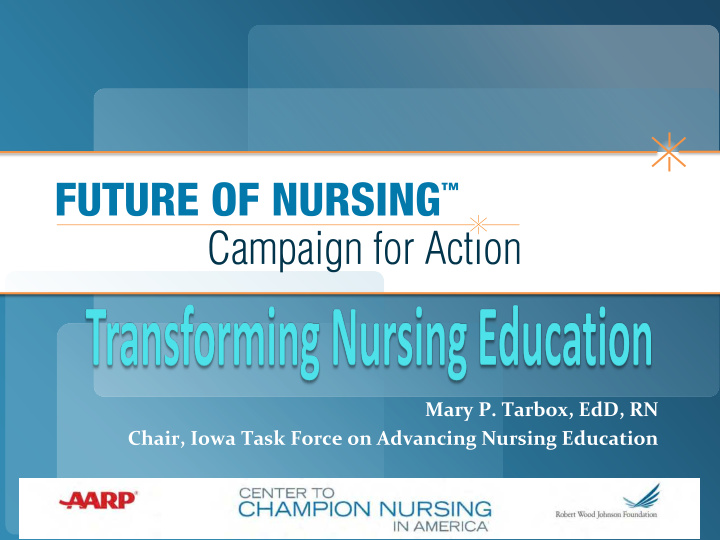



Mary P. Tarbox, EdD, RN Chair, Iowa Task Force on Advancing Nursing Education
• The Future of Nursing: Leading Change, Advancing Health • Committee of the Robert Wood Johnson Foundation • Initiative on the Future of Nursing, at the Institute of Medicine • Report is available online at: http://www.iom.edu/Reports/2010/The-Future-of- Nursing-Leading-Change-Advancing-Health.aspx
• Largest health care profession • Workforce of 2.74 million RN’s • Closest proximity to patients and other health care professionals • Knowledgeable of the HCDS • Scientific understanding of the care process • Essential Partners in Achieving Success of ACA and HCDS
• Re-conceptualize the role of nurses • Expand nursing faculty, increasing the capacity of nursing schools, and redesigning nursing education • Examine innovative solutions related to care delivery and health professional education • Attract and retain well prepared nurses in multiple care settings, (IOM, 2010, p. xiii).
Education Evidence: • Positive association between educational level of nurse and patient outcomes • 20% of BSN graduates get advanced degrees • 6% of ADN graduates get advanced degrees • Iowa has 45.1% BSN’s and goal is to attain 50% by 202 0 Education objectives: • Increase the proportion of nurses with BSN’s and higher degrees. • Increase the number of nurses with doctorates • Implement nurse residency programs • Promote lifelong learning
• Competency-based education • Standardized curriculum • RN to MSN educational programs • BSN degrees in Community Colleges
• Several meetings of the Task Force over the last five years. • Collaboration of ADN, BSN, DOE, BON and CNO’s • Early proposal to make achievement of BSN a contingent for continued licensure failed to gain support • Task force continued to work on transition and established a non-binding agreement among educational program • Continue work with CNO’s to determine ways to encourage nurses to achieve BSN • Last summit was November 2015
• Admission criteria for all nursing students – ACT of 20 – GPA of 2.5 – C or better in all Pre-requisite courses • Pre-requisites for all pre-nursing students a. Biology f. Anatomy & Physiology b. Chemistry g. College Algebra/ Statistics c. Psychology h. English Composition d. Dev. Psychology i. Microbiology e. Oral Communication j. Nutrition • Successful licensure as RN
• Educate potential students on the importance of the BSN as a goal for their education. • Educate potential students to consider one of two ways to achieve the BSN: 1. Complete the ADN degree first then pursue the BSN 2. Begin a BSN program and complete the degree • Continue to collaborate with educators, regulators and service representatives to increase the percentage of working nurses with BSN preparation.
• Report of new committee assessing progress toward IOM-FON 2010 report • Academic Progress in Nursing (APIN)- funding source • Investment of RWJF of $9 mi by the end of 2016 • Meant to advance strategies on academic progression and BSN-prepared nurse employment, – BSN completion programs at Community Colleges – State or regionally shared competency or outcomes-based curriculum – Accelerated options, RN to MSN – Shared state-wide or regional curriculum – Shared BSN Curriculum-Courses at both institutions
• Recommendations: • Continue Pathways Toward Increasing the Percentage of Nurses with a Baccalaureate Degree. • The FON, Campaign for Action, the nursing education community, and state systems of higher education should continue efforts aimed at strengthening academic pathways for nurses toward the BSN —both entry-level and BSN completion programs.
• Continue to assure there are BSN programs that readily accept ADN graduates and build on their previous nursing knowledge. • Continue to collect and analyze data associated with progress toward goal of 50% BSN prepared by 2020 and more as time goes on • Collaborate with all interested parties to assure that nurses practice to the full extent of their education including ADN to BSN graduates! • Consider ways to encourage working RN’s to pursue BSN or higher degrees.
1. Is it important to considered the differentiation of practice of ADN graduates and BSN graduates? If so, what would that differentiation look like? 2. What incentives could be developed to encourage working nurses, especially those with years of experience, to pursue the BSN? 3. What is the responsibility of educators and employers in assuring that the nursing workforce continues toward the national goal of at least 80% BSN prepared nurses.
Recommend
More recommend